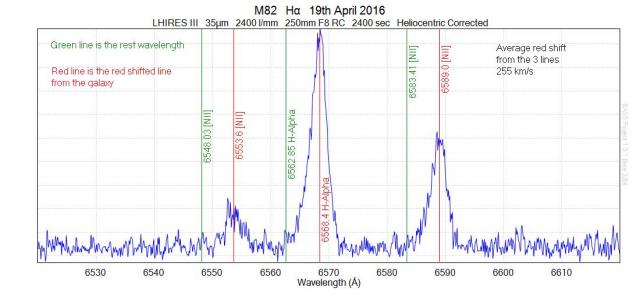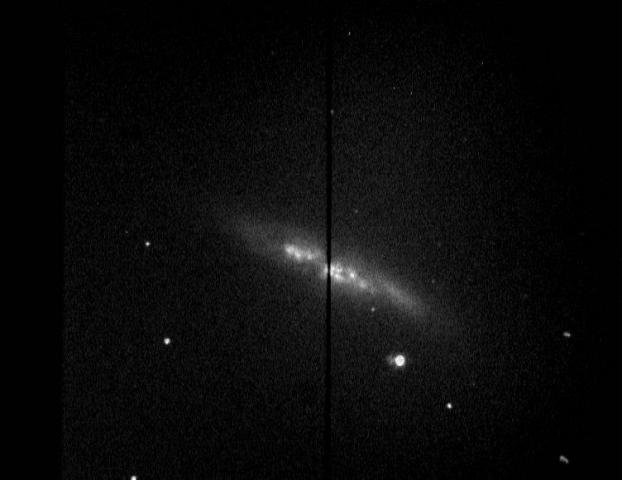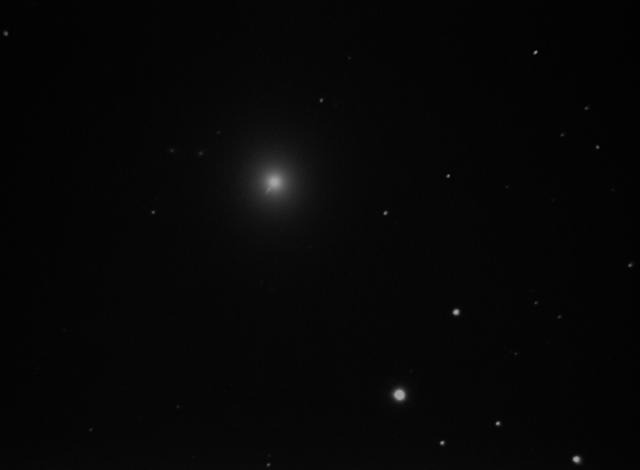› Forums › Spectroscopy › NGC 2903
- This topic has 19 replies, 4 voices, and was last updated 8 years, 10 months ago by
 Alun Halsey.
Alun Halsey.
-
AuthorPosts
-
25 February 2017 at 11:33 pm #573705
 Alun HalseyParticipant
Alun HalseyParticipantHi,
A few nights ago I had a go at NGC 2903 (galaxy in sickle of Leo) using my ALPY600/314L and 150ED Esprit apo triplet (f7). Placing the 23 micron slit of the guide module across center of the galaxy I noticed emission lines in the position of Hb and Ha regions of the spectra amongst the lines from the sky background. Using an A class star (beta UMa) to calibrate I think I have done it right but any tips/advice would be very much appreciated,being relatively new to spectroscopy I am still trying to get round the learning curve. Have uploaded the image of the spectrum (stack of 4x10min subs) and the profile which includes the A class star profile.
Attachments:
26 February 2017 at 9:47 am #577972 David BoydParticipant
David BoydParticipantHi Alun,
According to the NED database http://ned.ipac.caltech.edu/forms/byname.html NGC 2903 has a redshift velocity of +550 km/s which corresponds to a wavelength shift at H-alpha of +12A. It’s hard to tell exactly from your plot but that looks close to what you are seeing. The NED database also contains spectra of the galaxy which show it has a fairly flat continuum with only a few strong emission lines at H-alpha, H-beta and (probably) [N II] at 6584A, all of which you see faintly. So the stronger emission lines you are seeing such as sodium D at 5896A (which is not redshifted) may be sky background lines. Did you subtract the sky background during processing?
David
26 February 2017 at 10:25 am #577973 Alun HalseyParticipant
Alun HalseyParticipantHi David,
Thank you for your reply.
No, I have left the data of NGC2903 as is,I will return to it and do a subtraction. You are right though the much stronger lines are from my sky background and I used the sodium D (5896A) to match up with the sodium in the A class star,or am I wrong in doing this? I feel a lot happier now though that I have got the calibration nearly right if there is indeed a redshift 🙂
Regards
Alun
26 February 2017 at 11:14 am #577974 David BoydParticipant
David BoydParticipantHi Alun,
If you don’t have the Alpy calibration unit, you can use the Balmer lines in your A-type spectrum to find the polynomial which maps pixels into Angstroms. You can use that to calibrate your galaxy spectrum independently of the sky background lines and use the sky sodium line as a check that everything is correct. You can then measure the galaxy redshift in km/s using the H-alpha line (delta lambda x 300,000 / lambda) which is always a satisfying thing to do with a small scope in your back garden. Once you have done the background subtraction, you will probably find a small absorption line at the sodium wavelength in your spectrum due to absorption of light from the distant galaxy by sodium in our own galaxy.
Cheers,
David
26 February 2017 at 12:56 pm #577975 Robin LeadbeaterParticipant
Robin LeadbeaterParticipantHi Alun,
The ALPY600 is an impressive tool for measuring active galaxy redshifts. For example Etienne Bertrand has found it is possible to get down to mag 15-16 on active galaxy and QSO with a C8 scope. You might be interested in his growing collection that he has been reporting on the ARAS forum here.
http://www.spectro-aras.com/forum/viewforum.php?f=6
His latest ( QSO 1247+267 at z=2 and V mag 16) is here
http://www.spectro-aras.com/forum/viewtopic.php?f=6&t=1663&p=7726
Cheers
Robin
26 February 2017 at 1:22 pm #577976 Andy WilsonKeymaster
Andy WilsonKeymasterHi Alun,
That is an interesting spectrum. The hydrogen emission lines that you have picked up will be from HII regions within NGC 2903. Doing a little digging around I see that this galaxy has a high star formation rate. So it makes sense that it has a lot of bright clouds of hydrogen which will be forming stars.
Best wishes,
Andy
26 February 2017 at 5:41 pm #577983 Alun HalseyParticipant
Alun HalseyParticipantHi Robin,
Thank you for the link,I often visit this forum to learn more from you professionals 🙂 I had a look at Etienne’s threads and to be honest the math was waaaaayyy over my head (never was my best subject!) 🙁
Regards
Alun
26 February 2017 at 6:52 pm #577985 Alun HalseyParticipant
Alun HalseyParticipantHi Andy,
Thank you,I actually came by this galaxy by chance as I’d captured a few other targets earlier in the session and sat looking at the star map on PC and thought what next,slew to NGC2903 and was surprised to see the emission lines. Spectroscopy is by far much more interesting than just taking astro images :))
Regards
Alun
26 February 2017 at 6:52 pm #577984 Alun HalseyParticipant
Alun HalseyParticipantHi David,
No I didn’t go to the expense of the calibration module,hence the use of the Balmer lines as you suggeted. Had another go at calibrating in BASS,but this time I subtracted the sky background leaving the profile for the galaxy rather noisey,but then I realised it would be because the captured spectrum isn’t as defined as that of a star..Doh!! Anyway I have uploaded the resulting profile showing both the A class star and the galaxy,the sodium line has shrunk and the Ha emission line has risen.
Regards
Alun
26 February 2017 at 7:16 pm #577986 Andy WilsonKeymaster
Andy WilsonKeymasterHi Alun,
Your reminded me of when I took a spectra of M81 and M82. Like you I was just interested to see what I could see in spectra of galaxies. My setup is for high resolution spectra, so it is very hard to go faint and I just see a small region of the spectrum. M81 was almost entirely noise, while M82 though noisy did have some interesting features I could investigate.
Below are the spectrum and the view through my guide camera. It turns out I had placed the slit on some known HII regions called regions A and D. This allowed me to do a radial velocity calculation that showed a redshift of about 255 km/s.
It is nice to sometimes take a spectrum of an object without preconceptions. Then you can experience the joy of discovery, even if many others have been there before.


Cheers,
Andy
26 February 2017 at 7:35 pm #577987 Alun HalseyParticipant
Alun HalseyParticipantHi Andy,
I know of those plumes as I try to capture them in my H-alpha images:) Very interesting project you had there,will have to follow in your footsteps and have a go with the ALPY and my DIY 1200l/mm classical. One other target I have in mind,when Virgo gets a bit higher in the spring,M87, galaxy with a plume of material extending from a super massive black hole.
Regards
Alun
26 February 2017 at 7:55 pm #577988 Andy WilsonKeymaster
Andy WilsonKeymasterHi Alun,
M87 could be a very interesting target. I have no idea whether the features, like the plume or jet, are within reach of our spectroscopes. If they are then the results would be fascinating. The central black hole might show broad emission lines due to fast rotating gas, while a jet might show a big blueshift.
Cheers,
Andy
26 February 2017 at 8:05 pm #577989 Alun HalseyParticipant
Alun HalseyParticipantHere is an image of M87 I took using a QHY5L-II,it is a stack of 20 subs at exposure time of 20 seconds and the plume came out quite clearly so reckon it is do-able 🙂
Regards
Alun
 27 February 2017 at 9:26 am #577991
27 February 2017 at 9:26 am #577991 David BoydParticipant
David BoydParticipantHi Alun,
That looks good. You can now see emission lines of H-alpha, H-beta and H-gamma plus the two [N II] lines bracketing H-alpha and the dip at 5896 due to Na absorption in our galaxy. You could get three independent estimates of the redshift from the three Balmer lines. I’m guessing you haven’t applied a correction for instrument and atmospheric losses? If you did this it would remove the hump and you’d end up with a relatively flat spectrum similar to this one on NED http://ned.ipac.caltech.edu/spc1/2006/2006ApJS..164…81M/NGC_2903_nuc:S:Opt:mk2006_sp.png
Cheers,
David
27 February 2017 at 9:48 am #577992 Alun HalseyParticipant
Alun HalseyParticipantHi David,
Again thank you for this,I haven’t as yet carried out an instrument response,will return to the data and attempt the two corrections and see what I end up with:)
Regards
Alun
27 February 2017 at 4:01 pm #577993 Andy WilsonKeymaster
Andy WilsonKeymasterThat is a nice image for 400 seconds. I will be interested to hear how you get on with that project.
Cheers,
Andy
27 February 2017 at 10:39 pm #577994 Alun HalseyParticipant
Alun HalseyParticipantThank you Andy,will post result on this Forum if and when I get any data:) Also thank you all for your advice and tips on calibrating the profile of NGC 2903, in particular David for your help and guidance:) Here is my final attempt at this ,once again calibrated and instrument response corrected using BASS. Have labelled the Hb and Ha lines to show the redshift position of the two points.
Regards
Alun
28 February 2017 at 10:33 am #577995 David BoydParticipant
David BoydParticipantHi Alun,
Congratulations, that’s a nice well calibrated and corrected spectrum. You should upload it to Andy’s spectroscopy database.
Cheers,
David
28 February 2017 at 2:35 pm #577996 Andy WilsonKeymaster
Andy WilsonKeymasterHi Alun,
As David says, this spectrum would be a welcome addition the BAA Spectroscopy Database, and expect you have others.
The spectra need to be in 1D fits format with the BeSS fields populated. I know BASS can produce this format, so just let me know if you need any pointers. Otherwise just email me a sample 1D fits file when you are ready and I will use that to set you up in the database. I don’t put my personal email address online, but you can email me at vssdbm <at> britastro.org
Cheers,
Andy
28 February 2017 at 4:16 pm #577999 Alun HalseyParticipant
Alun HalseyParticipantHi David,Andy
Thank you both once again for your help and advice,have also taken you up on your invite to add my profile to your database. Have sent Email with the 1D FITS file of NGC 2903,I do have others but they are just the usual stars I used for getting aquainted to the world of spectroscopy (Vega,Capella a couple of Be stars).
Regards
Alun
-
AuthorPosts
- You must be logged in to reply to this topic.
